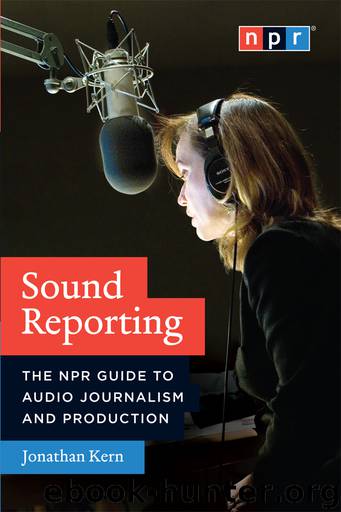Sound Reporting: The NPR Guide to Audio Journalism and Production by Jonathan Kern

Author:Jonathan Kern [Kern, Jonathan]
Language: eng
Format: epub
Publisher: The University of Chicago Press
On the Air
Many people have a hand in putting together any one newscast—producers, editors, and anchors. But the listener only hears one of them—the anchor. We can and should expect a high level of professionalism from a newsreader, but there are also ways other newscast staff can make his or her job easier.
An anchor on public radio should present the news in an authoritative and engaged manner. As a newscaster, you need to have a real understanding of the stories you present—so that your understanding can come across in your delivery. You don’t need to “sell” the news; just read in a natural, interested way. Your pace and delivery should vary—again, naturally—with the stories in the newscast. After all, if you were chatting in the hallway, you wouldn’t tell us about evidence that North Korea has developed nuclear weapons in the same tone of voice as you would if you were describing a Fourth of July celebration in San Francisco; so don’t become mechanical or monotonous when you read those stories on the air. “I just try to be affected by the story in a way that will reflect the content of the story,” Craig Windham says. “I think about the content. What am I talking about here? If people are dying, I’m thinking about what it’s like to be at a scene like that.”
We also expect a certain “polish” from newsreaders. You should be able to pronounce the names of people and companies and places without stumbling; you should know how to keep the sound of rustling papers to a minimum; and in general, you should uphold public radio’s high standards for on-air performances. The best way to do that is to take a moment and practice the newscast before you go into the studio. Even long-time newscasters rehearse. “I always read, and time, every story before I go on the air,” Corey Flintoff says.
If you’re producing or editing for newscasts, there are ways to help anchors out. Get in the habit of using pronouncers for any unfamiliar acronyms or name, including the names of new reporters (e.g., “Christine Peñaloza [pen-yuh-LOH-suh] has a report”). Question pronouncers you get from reporters or editors that don’t look right or seem ambiguous—the pronouncer “Ouagadougou [wah-guh-doo-goo],” for instance, isn’t as helpful as “Ouagadougou [WAH-guh DOO-goo].” And use pronouncers wherever the name occurs; just because we’ve indicated in one line that “Dunwich” is pronounced “DUH-nich” doesn’t mean we can drop the pronouncer if the same place name comes up again.5
Anyone writing copy for a newscast should write out numbers so that they’re unmistakable: Many anchors prefer “225-thousand” to either “two hundred twenty-five thousand” or “225,000.” And use punctuation suited for radio. Many newscasters prefer “U-S” to “U.S.,” for example, to avoid mistaking that last period for the end of the sentence if by chance “U.S.” falls at the end of a line, as in:
This is the first time there has ever been an all-women rifle team in the U.S. Army.
Similarly, it’s easier for anchors
Download
This site does not store any files on its server. We only index and link to content provided by other sites. Please contact the content providers to delete copyright contents if any and email us, we'll remove relevant links or contents immediately.
Cecilia; Or, Memoirs of an Heiress — Volume 1 by Fanny Burney(31331)
Cecilia; Or, Memoirs of an Heiress — Volume 3 by Fanny Burney(30933)
Cecilia; Or, Memoirs of an Heiress — Volume 2 by Fanny Burney(30889)
The Great Music City by Andrea Baker(21264)
We're Going to Need More Wine by Gabrielle Union(18072)
Bombshells: Glamour Girls of a Lifetime by Sullivan Steve(13107)
Pimp by Iceberg Slim(12929)
All the Missing Girls by Megan Miranda(12746)
Fifty Shades Freed by E L James(12448)
Norse Mythology by Gaiman Neil(11882)
Talking to Strangers by Malcolm Gladwell(11874)
Crazy Rich Asians by Kevin Kwan(8347)
Mindhunter: Inside the FBI's Elite Serial Crime Unit by John E. Douglas & Mark Olshaker(7833)
The Lost Art of Listening by Michael P. Nichols(6469)
Enlightenment Now: The Case for Reason, Science, Humanism, and Progress by Steven Pinker(6405)
Bad Blood by John Carreyrou(5767)
The Four Agreements by Don Miguel Ruiz(5510)
Weapons of Math Destruction by Cathy O'Neil(5034)
We Need to Talk by Celeste Headlee(4868)
